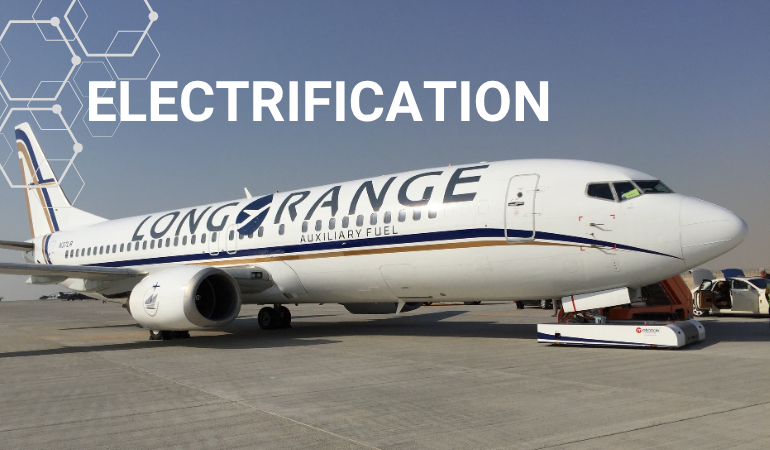The transition to ‘green airports’ is an essential step in achieving sustainable aviation and meeting the industry’s objective of net zero emissions by 2050. Electrification program grants for tenants offered by airport authorities as well as by federal and international funding programs support airports in transitioning to environmentally-friendly operations and infrastructure. We provide a brief overview of some electrification program grants available and what these grants look like.
Sustainability in Aviation: Electrification Program Grants for Airports
With climate change becoming an increasingly pressing concern, environmental awareness is increasing in both society and business policies across all industries. With environmental regulations subsequently becoming more stringent, the aviation industry faces mounting pressure to reduce its ecological impact. The goal of achieving net zero carbon emissions by 2050 makes sustainability one of the key trends currently shaping the future of aviation.
In our blog post “Top 3 Sustainability Trends in Aviation to Look for in 2025”, we have discussed the key sustainability trends and innovations that are set to shape a greener future. Here, we focus on how electrification program grants support airports in electrifying their operations and infrastructure in order to effectively reduce emissions.
What electrification program grants for airports are available? A Brief Overview
There are different electrification program grants for airports available that support tenants in acquiring electric ground support equipment (GSE) and sustainable charging infrastructure. What do these grants for airport electrification look like? Explore with us a selection of electrification funding options available in the United States and Europe, especially in Germany.
Airport Electrification Funding in the United States
Airport Infrastructure Grants (AIG)
The Federal Aviation Administration’s (FAA) Airport Infrastructure Grants (AIG) are part of the Infrastructure Improvement and Jobs Act (IIJA). The program has started in 2022 and provides $ 14.5 billion funding over a period of five years, including up to $ 2.39 billion for primary and up to $ 500 million for nonprimary U.S. airports per fiscal year. Airports can invest the allocated AIG funds, among others, in sustainability projects, including electrification efforts.
Airport Improvement Program (AIP)
“If it supports environmental improvement, AIP is likely to help fund it.”
The FAA’s Airport Improvement Program (AIP) provides grants to public agencies and, under certain circumstances, to private owners and entities for the development of public-use airports that are included in the National Plan of Integrated Airport Systems (NPIAS). Projects eligible for AIP funding include, among others, improvements related to environmental concerns.
Voluntary Airport Low Emissions (VALE) Program
The FAA’s Voluntary Airport Low Emissions (VALE) Program is a grant for airport emissions reduction initiatives. Since 2004, VALE supports projects that improve airport air quality and provides Airport Emission Reduction Credits (AERCs) recognized by the Environmental Protection Agency (EPA) and State Air Quality Agencies. These air quality credits can be used for future airport development. The program encourages airport sponsors to implement clean technology in order to reduce on-airport emissions and meet state-related air quality requirements under the Clean Air Act.
The VALE program supports airport sponsors in financing mobile or stationary equipment that reduces emissions such as low emission vehicles and infrastructure-related air improvement projects. Airport sponsors can fund VALE projects through Airport Improvement Program (AIP) grants and Passenger Facility Charges (PFCs).
Electrification projects eligible for funding through VALE include:
- Alternative fuel vehicles, for instance electrically powered, instead of conventional diesel or gasoline vehicles as well as related recharging or refueling stations.
- Electric or hydrogen-powered ground support equipment (GSE) as well as related recharging or refueling stations. For instance, fully-electric, towbarless Mototok tugs allow airports to completely electrify their ground handling operations and are the sustainable alternative to conventional diesel tugs.
- Further electrification projects fundable through VALE include the implementation of electric charging infrastructure, gate electrification and remote ground power as well as the supporting electrical infrastructure.
Information on the eligibility criteria and the application process of the VALE program are provided online. In general, commercial service airports are eligible for VALE funding, especially if located in areas of nonattainment or maintenance of National Ambient Air Quality Standards (NAAQS). Sponsor reimbursement ranges from 75% for large to medium hub airports to up to 90% for small hub airports. The annual deadline for project proposals is November 1.
Airport Zero Emissions Vehicle (ZEV) and Infrastructure Pilot Program
“ZEV funding has enabled clean airport operations since 2012.”
The FAA’s Airport Zero Emissions Vehicle (ZEV) and Infrastructure Pilot Program supports the use of zero emissions technologies at airports in order to efficiently reduce emissions and improve airport air quality. Since 2012, the program enables airport sponsors to acquire zero emission vehicles and to modify or construct related infrastructure, using Airport Improvement Program (AIP) funds.
Project types eligible for funding include airport vehicles with all-electric or hydrogen-powered drive that do not produce emissions of any criteria pollutant. This includes, for instance, clean ground support equipment (GSE) such as fully-electric Mototok tugs with zero emissions. The program additionally funds infrastructure required to operate ZEVs, such as refuelling or recharging stations.
“If you’re eligible for AIP grants, you’re likely eligible for ZEV funding.”
Information on the eligibility criteria and the application process for the Airport Zero Emissions Vehicle (ZEV) and Infrastructure Pilot Program is provided online. In general, public-use airports eligible for AIP grants in the National Plan of Integrated Airport Systems (NPIAS) are also eligible for funding through the Airport ZEV Program. Sponsor reimbursement ranges from 75% to 90%, depending on airport size. The annual deadline for project proposals is November 1.
The Airport ZEV Program is closely aligned with the FAA’s VALE program. However, while the VALE program is the ideal funding solution for large infrastructure emission reduction projects, the Airport ZEV Program is ideal for funding zero emission airport vehicles and related infrastructure.
Airport Electrification Funding in Europe and Germany
Alternative Fuels Infrastructure Facility (AFIF)
The European Union’s Alternative Fuels Infrastructure Facility (AFIF) program under the Connecting Europe Facility (CEF) provides funding for projects related to alternative fuels and sustainable transport infrastructure. This also includes projects for airport electrification, such as electrifying ground operations and implementing recharging infrastructure. The funding aligns with the European Green Deal and the EU’s long-term target of achieving net zero emissions by 2050.
BMV Funding Calls for Ground Power in Germany
The German Federal Ministry for Transport (BMV) regularly launches funding calls for ground power units at German airports. In 2025, the BMV launched its third funding call with approximately 3 million euros available.
The BMV provides funding for the acquisition of environmentally-friendly, mobile and stationary ground power systems to supply airplanes on the ground while they are being maintained, loaded, and refuelled. It further funds the procurement of the recharging and refuelling infrastructure required.
Ground power units based on alternative technologies, for instance using direct current, batteries, or hydrogen, not only significantly reduce CO2 emissions, but also reduce noise and improve air quality in the apron, thus improving working conditions.
Natural and legal persons in Germany are eligible to apply for funding through the BMV ground power directive. The funding rate is up to 70%. Applications to the BMV funding calls are approved by the Federal Office for Administrative Services (BAV). All information on current BMV funding calls, eligibility, and the application process is available online on the website of the BAV.
“From ground power to electric tugs: German funding programs are accelerating airport electrification.”
Funding for Electric Ground Support Equipment (GSE) by German Federal States
In Germany, there are also different electrification grants for airports available that are provided by federal states. These grants help airports overcome investment barriers and offer opportunities for electrifying ground support equipment.
For example, in 2025 Fraport, the operator of Frankfurt Airport as the world’s leading airport for global hub connectivity, has been allocated 213.000 euro funding for the procurement of two fully-electric tugs by the Hessian Ministry of Economics, Energy, Transport and Housing as part of their “Promotion of Electric Mobility” program. In 2022, the State of Hesse already funded the expansion of fast charging stations on the apron with a 460.000 euro grant as part of the “Fast Charging 4 FRA” program.
Conclusion to Electrification Program Grants for Airports
Sustainability is one of the key trends currently shaping the future of aviation. ‘Green airports’ are an essential component of achieving sustainable aviation and the climate goal of net zero carbon emissions by 2050. Electrification of airport operations and infrastructure, in turn, is crucial in the transition to sustainable airports.
There are different grants available that provide support for airport electrician efforts and help airports significantly reduce emissions. These grants provide, for instance, funding for electric GSE such as fully-electric Mototok tugs as a sustainable alternative to conventional diesel tugs. Additionally, they fund the implementation of electric charging infrastructure.
In the United States, the FAA’s Voluntary Low Emissions (VALE) Program and the Zero Emissions Vehicle (ZEV) and Infrastructure Pilot Program are potential sources of funding for emission reduction projects. In Europe, the European Union’s Alternative Fuels Infrastructure Facility (AFIF) program provides potential funding for airport electrification. In Germany, the BMV regularly launches funding calls for the procurement of sustainable ground power units. In addition, federal states in Germany may provide funding for the acquisition of electric ground support equipment.
We are happy to help you find out more about how you can successfully electrify your ground handling operations using fully-electric Mototok tugs – just contact us.
To make your research easier, we’ve compiled all mentioned funding programs into one quick-reference list:
- Airport Infrastructure Grants (AIG)
- Airport Improvement Program (AIP)
- Voluntary Airport Low Emissions (VALE) Program
- Zero Emissions Vehicle (ZEV) & Infrastructure Pilot Program
- Environmental Protection Agency (EPA) – Airport Emission Reduction Credits (AERCs)
- Passenger Facility Charges (PFCs)
- Connecting Europe Facility (CEF)
- Alternative Fuels Infrastructure Facility (AFIF)
- BMV Ground Power Funding Calls (Germany)



Comments